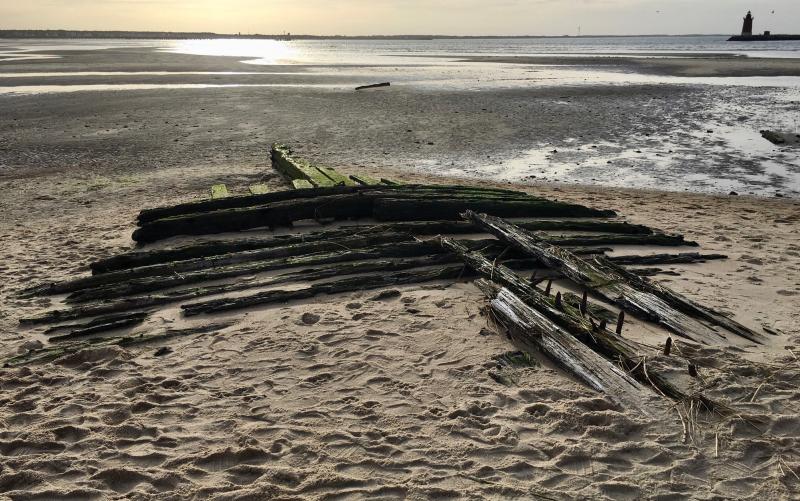Shifting sands at cape reveal century-old shipwreck
Cape Region artist Abraxas Hudson once told me during a sketching class that bold is genius. Specifically, he was discussing lines in drawings.
When he recently sent through a photo of the remains of a shipwreck inside the point at Cape Henlopen, the image put me in mind of his statement. The timbers of that old wreck are nothing if not bold. The same can be said of the heavy iron spikes sticking up from the planking of the vessel.
Paul Nasca, curator of archaeology for Delaware’s Division of Historical and Cultural Affairs, said the spikes and copper nails are part of what he and former state marine archaeologist Craig Lukezic used as clues to date the wreck to the late 19th or early 20th century. “When it was built, use of the iron hardware indicated the vessel was meant for short-lived use,” said Nasca. “Iron fasteners deteriorate quickly.” But, according to internet sources, they were less expensive than the bronze spikes used on earlier vessels.
Nasca said the vessel could have been a barge. But with little more than the timbers and planking, keel and ribs visible to the hundreds of beachcombers who have inspected the wreck over the past couple of years, Nasca said there is nothing to define the wreck as a particular ship.
Lukezic and Nasca first examined the ship remains in 2018. “That’s when shifting sands first exposed the timbers and we were contacted by park officials. We looked at it, made drawings of it, measured it and probed it. But all we could figure out was that it was a piece of a ship from that era. There was a lot of wharfing along the shoreline in the early 20th century so we wondered whether it was a hulk or a portion of a ship that had been cut up.”
Nasca said Google aerial photographs from October 2018 show the wreck visible under shallow water. “It’s been covered and uncovered and covered back up again through the decades. We do know the remains extend all the way from the shore and into the dunes there.” Using a stiff metal probing rod, the men were able to detect the wreck at least into the dune. “We don’t know how much farther it goes into the dunes. That’s as far as we could probe for it with the equipment we had and without disturbing the dunes,” said Nasca. He said the exposed, visible timbers measure about 20 feet long, but the remainder under the sand extends at least another 40 feet into the dune.
“All we can say is that the type of vessel is indeterminate at this point. It definitely harkens back to a time when Lewes was a different place. It’s a great little piece of history that serves as a reminder to visitors of that era.”






















































